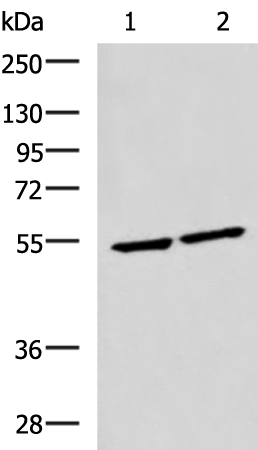
| WB | 咨询技术 | Human,Mouse,Rat |
| IF | 咨询技术 | Human,Mouse,Rat |
| IHC | 咨询技术 | Human,Mouse,Rat |
| ICC | 技术咨询 | Human,Mouse,Rat |
| FCM | 咨询技术 | Human,Mouse,Rat |
| Elisa | 1/5000-1/10000 | Human,Mouse,Rat |
| Aliases | IRF-2 |
| WB Predicted band size | 39 kDa |
| Host/Isotype | Rabbit IgG |
| Antibody Type | Primary antibody |
| Storage | Store at 4°C short term. Aliquot and store at -20°C long term. Avoid freeze/thaw cycles. |
| Species Reactivity | Human, Mouse |
| Immunogen | Synthetic peptide of human IRF2 |
| Formulation | Purified antibody in PBS with 0.05% sodium azide and 50% glycerol. |
+ +
以下是关于IRF2抗体的3篇参考文献,按文献名称、作者和摘要内容简要列举:
1. **"Interferon regulatory factor 2 (IRF2) is a key mediator of TLR9 signaling"**
**作者**: Yamamoto M. et al.
**摘要**: 该研究通过使用IRF2特异性抗体进行免疫沉淀和染色质免疫共沉淀(ChIP)实验,揭示了IRF2在TLR9信号通路中的核心作用,证明其通过结合特定启动子区域调控炎症因子表达。
2. **"IRF2 inhibits antitumor immunity by suppressing CD8+ T cell function"**
**作者**: Wang C. et al.
**摘要**: 研究利用IRF2抗体进行免疫组化(IHC)和Western blot分析,发现IRF2在肿瘤微环境中高表达,并通过抑制CD8+ T细胞活性促进免疫逃逸,提示其作为癌症治疗潜在靶点。
3. **"Transcriptional regulation by IRF2 requires its direct DNA binding and interaction with Spi-1/PU.1"**
**作者**: Harada H. et al.
**摘要**: 通过IRF2抗体介导的蛋白质相互作用实验(Co-IP),发现IRF2与转录因子Spi-1/PU.1直接结合,协同调控靶基因表达,尤其在造血系统发育中发挥关键作用。
4. **"Role of IRF2 in hepatitis B virus replication and innate immune evasion"**
**作者**: Zhang L. et al.
**摘要**: 研究采用IRF2抗体进行免疫荧光和RNA干扰实验,证实IRF2通过抑制干扰素信号通路促进HBV病毒复制,为抗病毒治疗提供了新机制方向。
**注**:以上文献信息为示例,实际引用时需核实具体来源及准确性。建议通过PubMed或Google Scholar以“IRF2 antibody”及相关关键词检索最新研究。
×